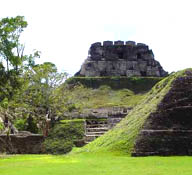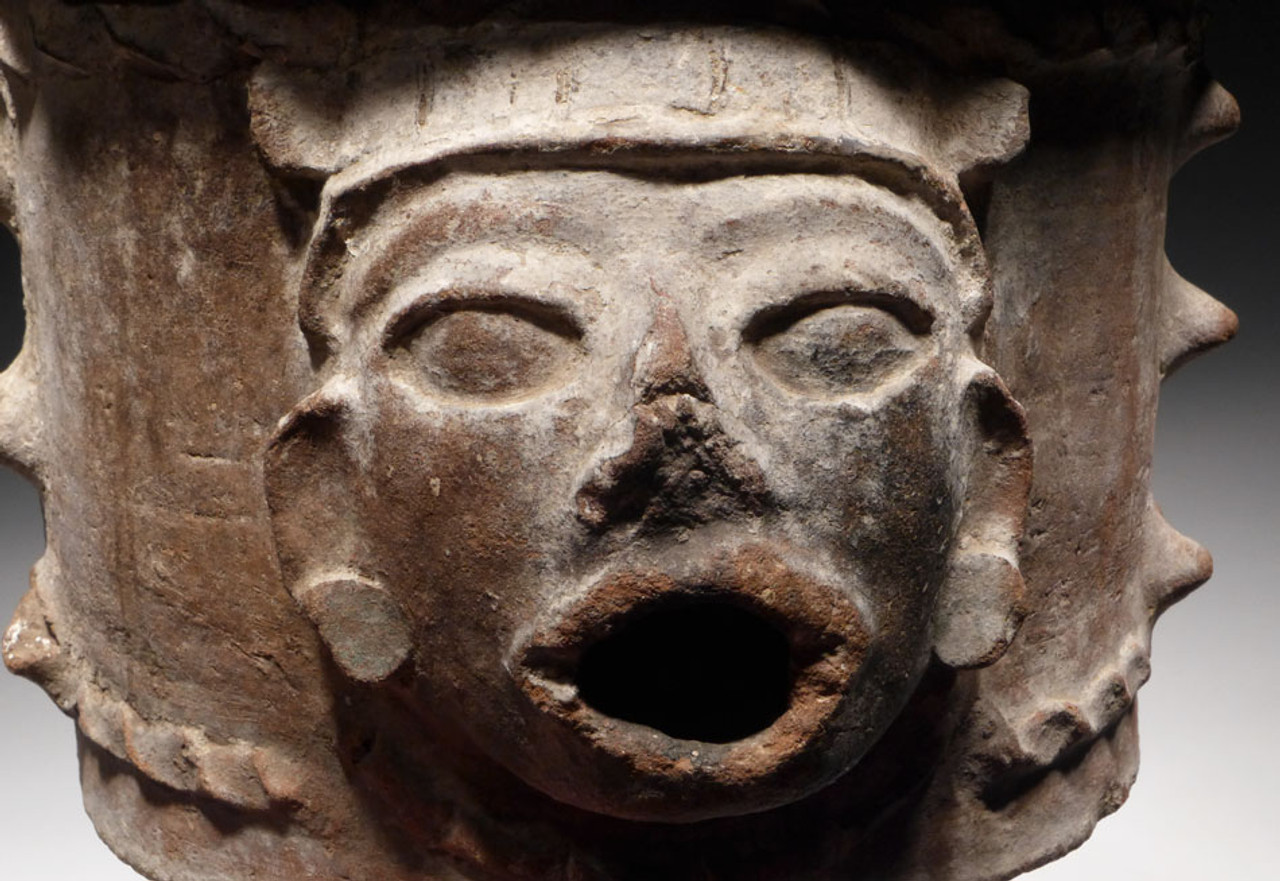Product Description
With increasing focus being placed today on looted artifacts, provenance has become even more important than ever. The most solid form of legal provenance is that of being able to acquire a piece formerly housed in a museum collection. This is one of those rare opportunities! For discriminating collectors of rare Mayan ceremonial objects, this is a magnificent ceramic shrine urn depicting what appears to be an ancestor and most likely used for ancestor worship. Its value and rarity is further enhanced by the fact that it was formerly a piece in the famous Mint Museum of Charlotte, North Carolina, USA. In this enormous Pre-Columbian collection, there were over a thousand remarkable pieces donated by the Dr. Francis Robicsek. A number of years ago, a few hundred pieces of the collection were sold by the museum much to the distaste of Dr. Robicsek. This piece is one of them. We acquired this piece from a former collector who acquired it by auction directly from the museum. Pieces of this magnitude, with solid museum provenance, have proven themselves in major auctions, to be top investment performers, forever increasing in value due to their extreme scarcity in the public market.
Ancestor worship in Mayan religion often included urns that contained the incinerated remains of the venerated deceased. These could have been noble members of ruling families or famous leaders in battle. Often, shrines were built around the urns and these urns were considered representatives of the deceased. On festive occasions, the urns were ritually "fed". The mouth of this urn shows such wear. The thorn-like projections on the sides represent the thorns of a young kapok tree - considered the "Tree of Life" by the Mayans. Its trunk connected the living world with the underworld and the stars above.
This urn was originally found INTACT and COMPLETE as shown. Its robust construction most likely protected it over the ages. Minor loss to rim edge but otherwise intact and in CHOICE preservation with original heavy layers of deposits from use, caked on the inside surfaces. Original Mint Museum label remains on the underside.
The mouth of the figure shows extensive ancient wear, probably from wear by being "fed" by the original Mayan participants of the rituals it was central to. This alone, makes it an extraordinary piece as RARELY do any ancient vessels show much if any use. On the contrary, this specimen shows EXTENSIVE shrine use both by the wear on the mouth of the three-dimensional head, and the evidence of what appears as layers of ash, mineralized to the interior.
Legal Pre-Columbian pieces like this, in superb condition with solid provenance from a museum, are EXTREMELY RARE and collectors of Pre-Columbian pottery especially value provenance from the Mint Museum. Large premiums are paid for pieces like this in the market today where provenance is becoming increasingly important of objects from this geographical region and culture. An opportunity like this is a once-in-a-lifetime chance and anyone wishing to acquire a truly special piece should take note.
With our highest recommendations for fanciers of the magnificence of the Pre-Columbian cultures of ancient Central America. This is a very unusual example of Mayan art and ritual in ceramic.
HEAVILY USED SHRINE URN WITH A MYSTERIOUS "PRESENCE" - AN EXCEEDINGLY RARE SPECIMEN OF COMMUNAL MAYAN RITUAL!!!
PRE-COLUMBIAN PIECES WITH LEGAL PROVENANCE FROM A MUSEUM ARE THE MOST PRIZED AMONGST TOP COLLECTORS
Of all the ancient cultures of the Americas, no civilization has held more intrigue and secrets for so long as that of the Mayans. In 1960, their language code of glyphs was finally deciphered and forever changed our view of what we initially thought was a peaceful and harmonious society. On the contrary, the Mayan Culture of the latter years was bathed in the blood of vicious warfare and astounding levels of human sacrifice. Their technology was so advanced it is no wonder many believe they received intelligence from extra-terrestrials. Despite our recent discoveries of Mayan mathematics, astronomy and calendar technology, the Mayans still leave us with many mysteries. Their love of war caused them to manufacture spectacular weapons with inherent beauty and artistry. Their ceramics depict a fascinating culture of status, sacrifice and deep religious devotion to a number of strange gods.
All surfaces exhibit impacted sediment and mineral patina deep in microscopic crevices - traits ONLY seen in AUTHENTIC SPECIMENS.
HISTORY
 Of all the ancient cultures of the Americas, no civilization has held more intrigue and secrets for so long as that of the Mayans. In 1960, their language code of glyphs was finally deciphered and forever changed our view of what we initially thought was a peaceful and harmonious society. On the contrary, the Mayan Culture of the latter years was bathed in the blood of vicious warfare and astounding levels of human sacrifice. Their technology was so advanced it is no wonder many believe they received intelligence from extra-terrestrials. Despite our recent discoveries of Mayan mathematics, astronomy and calendar technology, the Mayans still leave us with many mysteries. Their love of war caused them to manufacture spectacular weapons with inherent beauty and artistry. Their ceramics depict a fascinating culture of status, sacrifice and deep religious devotion to a number of strange gods.
Of all the ancient cultures of the Americas, no civilization has held more intrigue and secrets for so long as that of the Mayans. In 1960, their language code of glyphs was finally deciphered and forever changed our view of what we initially thought was a peaceful and harmonious society. On the contrary, the Mayan Culture of the latter years was bathed in the blood of vicious warfare and astounding levels of human sacrifice. Their technology was so advanced it is no wonder many believe they received intelligence from extra-terrestrials. Despite our recent discoveries of Mayan mathematics, astronomy and calendar technology, the Mayans still leave us with many mysteries. Their love of war caused them to manufacture spectacular weapons with inherent beauty and artistry. Their ceramics depict a fascinating culture of status, sacrifice and deep religious devotion to a number of strange gods.
Archaeologists divide the Mayan Culture into different periods - LATE PRE-CLASSIC / PROTO-CLASSIC (300 BC - 300 AD), EARLY CLASSIC (300 AD - 600 AD), LATE CLASSIC (600 AD - 830 AD), TERMINAL CLASSIC (830 AD - 950 AD). The earliest days of the Maya date back to 2000 BC when small farming villages first appeared in the highlands and Pacific coastline of Guatemala. Crops such as corn, squash and beans made up the staple of their diet and are believed to have been brought from previous migration through Mexico. The Maya pottery styles were unique to the early Maya settlements, though. By 1000 BC, villages sprang up in the lowland regions. The Maya lived in the same locations for centuries and in a continuous state of architectural improvement and expansion leading up to the magnificent 'super-cities' we associate with them today. By 300 AD. full-scale cities were being built with stone featuring massive plazas, temples and pyramids reaching 20 stories high.
It is no wonder that some believe that extra-terrestrial beings brought their knowledge to the Maya. By 300 AD, the first inscriptions suddenly appeared in Maya sites. These early inscriptions were so beautiful it was as if the gods had delivered it to the Mayan themselves! Forward to 600 years later and the inscriptions cease. The first comprehensive writing system in Pre-Columbian America was invented by the Maya. Among the mysteries of the Maya are their amazing understanding of astronomy along with the development of an accurate calendar and mathematical system. Their number system was based on units of 20 and included a concept of 'zero'.
The skills of the Mayan craft are exemplified in their stone and wood carvings, flaked stone objects, pottery and personal adornment. Much of their art centers around their devotion to a religion that is both fascinating and gory. Blood-letting rituals were the norm and many acts of war were motivated by the capture of vast numbers of their enemies for ritual human sacrifice that would run for days on end, forming lakes of blood and fat at the bases of their stone pyramids that defy architectural explanation.
Our understanding of the fascinating MAYAN CULTURE was completely wrong and misinterpreted until as recent as the 1960, when major achievements were made in the deciphering of their glyph language. Elaborately designed ceremonial cities lacking any obvious defenses initially led us to believe that the Mayans were a peaceful theocracy living in ideal harmony with their environment and each other. We could not have been further from the truth. Lowland city-states lived in constant warfare with one another and the thirst of their gods for human blood and sacrifice seemed impossible to satiate.
Perhaps a lesson for us today, recent scientific analysis of the demise of the highly advanced Mayan civilization now answers the biggest mystery of all - "What ever happened to the ancient Mayans?". Long-term high population density (500 people per square mile - the highest in the world at the time) of unbelievable proportions put a strain on their agricultural system that was impossible to sustain. The effects of nutritional deficiencies are evident in bone and tooth analysis on graves dating to the Late Classic Period. It is most probable that starvation put unbearable sociopolitical stress on the society to either kill each other for food or die of hunger necessitated by the technological advancement of warfare and its escalation.
 US DOLLAR
US DOLLAR
 EURO
EURO
 AUSTRALIAN DOLLAR
AUSTRALIAN DOLLAR
 CANADIAN DOLLAR
CANADIAN DOLLAR
 POUND STERLING
POUND STERLING
























